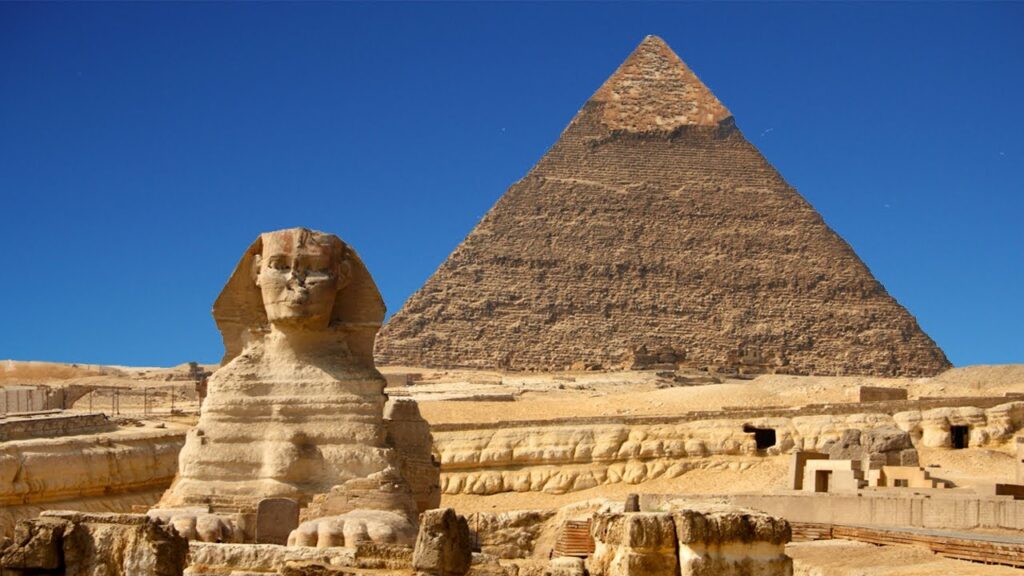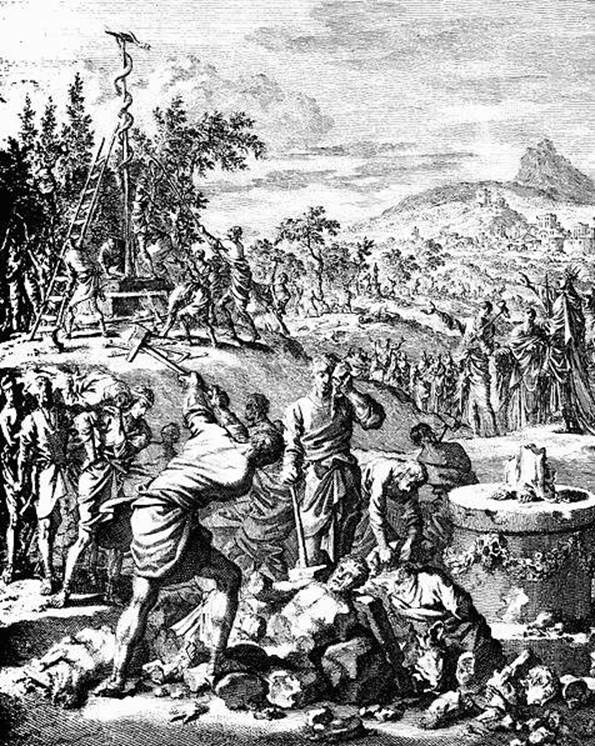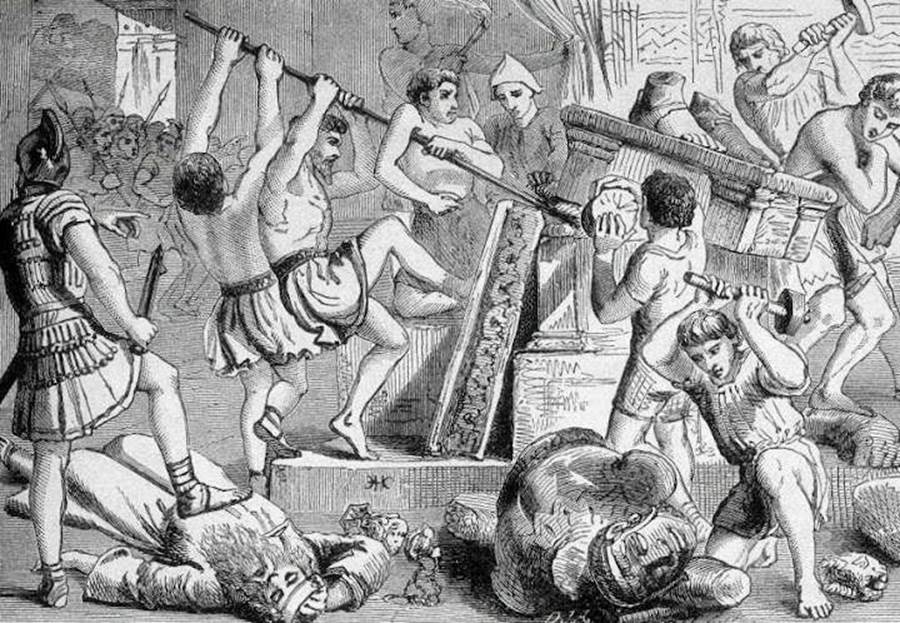EGYPTIAN?

ALEXANDRIA?
In his book Berossus and Genesis, Manetho and Exodus, Gmirkin “argues that the Hebrew Pentateuch was composed in its entirety about 273–272 BCE by Jewish scholars at Alexandria that in later traditions have been credited with the Septuagint translation of the Pentateuch into Greek.”
Gmirkin’s theory of the Pentateuch’s late date is “demonstrated by literary dependence on Berossus and Manetho,” priests of Babylon and Egypt, respectively, during the third century BCE, and essentially constitutes the “definitive overthrow of the chronological framework of the Documentary Hypothesis.”
He concludes:
…these multiple lines of evidence are consistent with the composition of the Pentateuch having taken place in 273–272 BCE. Analysis of the sources utilized in the Pentateuch point to Jewish access to Greek manuscripts of the Great Library in Alexandria. Authorship of key portions of the Pentateuch by Jewish scholars knowledgeable in Greek, and having access to Alexandria’s library in 273–272 BCE, points to the identity of the authors of the Pentateuch with the team of seventy (or seventy-two) Jewish scholars whom tradition credited with having created the Septuagint translation about this same time through the generous patronage of Ptolemy II Philadelphus.
We would not be surprised if Alexandria played a greater role then the mere translation of the Hebrew text into Greek. Yet, the Hebrew text clearly contains older sections composed centuries before this era, which could be passed along orally or in individual texts. In any event, Mosaic attribution cannot be sustained.
ANCIENT EGYPTIAN WORDS
In attempting to assert that Moses did write the Pentateuch, Christian apologists claim that “50 words in the Torah are ANCIENT EGYPTIAN and that authentic Egyptian details are present in the text that no later redactor could know.” The fact is that it would be quite easy for a later redactor to know much about Egypt, since not only was it close by and in constant communication with the Levant—having occupied the territory on and off for centuries—but also there existed many thousands of Egyptian writings from which to draw.
If the writers of the Torah knew 50 ancient Egyptian words, then some of these scribes likely were able to read the ancient Egyptian texts to a certain extent, which means the terms could have been copied from these writings, including various “historical” details. However, even then the Bible writers are very vague and do not present discernible historical details, such as dates or pharaohs’ names.
SAVIOR OF THE WORLD AND AGE
45 Pharaoh gave Joseph the name Zaphenath-Paneah and gave him Asenath daughter of Potiphera, priest of On, to be his wife. And Joseph went throughout the land of Egypt. Gen 41:45
One of the Egyptian terms in the Bible, צפנת פענח Tsaphnath phanehh or Zaphnathpaaneah, is essentially the same as the Coptic: Psontom phanech, which appears at a much later date, demonstrating the term’s continued currency, such that it could have been known to scribes during the late first millennium BCE .
The Septuagint renders this Egyptian title Ψονθομφανηχ Psonthomphanex, while Josephus has it as Ψοθομφάνηχον Psothomphanechon, one of some 11 different variations in copies of the historian’s works.
Strong’s Concordance (H6847) defines this term as “treasury of the glorious rest,” while the New Living Translation (NLT) renders the name as “God speaks and lives.” In his Vulgate Bible, St. erome/Hieronymus (347–420 AD/CE) translates the phrase into Latin as Salvatorem mundi or “savior of the world,” while Gesenius’s Lexicon relates the connotation of “savior of the age.”
In consideration of the popularity of the Egyptian religion, this appellation, which Massey traces to Egyptian myth, may have been used commonly for many centuries. What it also reflects is that the Egyptians had the concept of a “world savior” long before Christianity. Indeed, one of these saviors was the god “Shu,” whose name resembles “Yehoshua,” “Yeshua” and “Joshua,” a moniker denoting “salvation” or “Yahweh saves” and rendered later as “Jesus.”
Even if this Egyptian word is very ancient, there is little reason a writer centuries later could not have known terms from more archaic Egyptian to utilize for realism, particularly if the term was important and still in use. Fiction writers often use archaicisms and assorted other period pieces in placing their fictions in a historical setting.
SEMITIC AND EGYPTIAN LANGUAGE CONNECTIONS
Oddly enough in consideration of their physical proximity, a misconception lingers that the Semitic and Egyptian languages have little in common. Contradicting this erroneous impression, renowned Egyptologist Dr. Alan Gardiner (1879–1963), who specialized in Egyptian language, states:
Unfortunately the origin of the EGYPTIAN LANGUAGE lies so far back in the uncharted past that only little that is certain can be said about it. Since it is generally agreed that the oldest population of Egypt was of African race, it might be expected that their language should be African too. And in fact many affinities with Hamitic and in particular with Berber dialects have been found, not only in vocabulary, but also in verbal structure and the like. On the other hand, the relationship with Semitic (Hebrew, Arabic, etc.) is equally unmistakable, if not greater.
THE NAME SHEM
One important apparent etymological connection between Israel and Egypt occurs in the word shm or shem. In the languages of both nations, Shem is a title of divinity, meaning “mighty one” or “Power” in Egyptian, and “Name” as in the “Name of God” in Hebrew.
Furthermore, in Egypt the sun often was deemed shm or “power” in the “eulogies of the offering” of the sun hymns. Hence, there exists a solar correlation between the Egyptian shm and Semitic shmsh or Shamash, the Babylonian sun god. This fact could not have been lost on the Jews, who looked for pithy puns with cosmic connections demonstrating divine order.
TAKEN FROM SOURCE EGYPT?
Even with this proximity and commonality, Bible apologists claim that the Pentateuch must have been written by Moses, because he was bilingual and knew both Hebrew and Egyptian, whereas “a thousand years later no Jews would have known that language” and that the Jews “might have known Coptic, but not hieratic or hieroglyphics which by this time were lost.”
The contention is made by Messianic/Netzari Jewish minister Andrew Gabriel Roth:
Psalm 104 was written 400 years before David was even born and found on the tomb wall of Akenaten, the first known Egyptian king to worship a single deity.
EA Wallis Budge, one of the leading Egyptoligists [sic] of the 19th century, translated the tomb text and confirmed this was nearly verbatim. Moses even knew how long it took to embalm Jacob Egyptian style—70 days. That little nugget isn’t even suggested until a thousand years after Moses by Herodotus, and his earliest mss [manuscripts] are hundreds of years after him. Not even the most liberal scholars date the Torah books as post-exilic. Similarly, burying someone in the sand was an ancient Egyptian ritual that pre-dates their writings. Only someone reared in the royal court could have known these things, and even if he [may] disagree with these details, there are many more examples where they came from.
All of these details would have been knowable and readily available centuries later, because of the huge literary record of the Egyptians, and the emulation of their religious traditions and practices, as well as their previous long-term presence in Canaan. It is noteworthy that Psalm 104 is recognized to have a relationship with the writings of the Egyptian pharaoh Amenhotep IV or Akhenaten (d. c. 1336 BCE), a correlation discussed later. This fact of “borrowing” in the Bible is highly significant and reveals the reliance on non-Israelite texts and themes, as we assert happened also with the bulk of the Pentateuch.
EGYPTIAN BURIAL
In consideration of the fact that possibly half a billion or more people followed the Egyptian religion over its 3,000 years of popularity, the detail of the Egyptian burial likely was known widely by the time the Pentateuch actually was written. Burial in sand especially would have been known quite readily since, by that era, millions of poor people in particular would have been buried in the desert. This burial is logical for people of the deserts, especially those focused on preservation, as such entombment was the least expensive way to desiccate and mummify remains.
The reality is that a people subjugated in a foreign country for hundreds of years would include much more Egyptian in their language after all that time, particularly as concerns whatever tools or accoutrements they needed as supposed slave laborers during that long period. All innovations in Egypt proper likely would be termed in Egyptian, and if the Israelites had taken any of these novelties with them, they surely would import their Egyptian names as well.
The same might be said of at least some of the mass of booty the Israelites reputedly obtained from the Egyptians, including images of deities with Egyptian names. If the Exodus were true, and the Israelite slaves had lived in Egypt for centuries, with Moses purportedly having been born and raised in an Egyptian household, one would expect many more than just 50 Egyptian terms in the Pentateuch, which contains some 14,691 Hebrew words.
HEBREW EMERGENCE
Moreover, since the Hebrew alphabet developed only after the “Phoenician” alphabet was created around 1050 BCE, Moses could not have written the Pentateuch in it some 200 or more years earlier. Prior to that development, cuneiform and Egyptian hieroglyphs/alphabet were used, with the latter “adapted for use with Semitic writing systems as early as 2000 BCE.” It seems highly improbable that Moses would have written in Hebrew in the second millennium using cuneiform, hieroglyphs or the apparently primitive Semitic script called “Proto-Sinaitic” (c. 1700–c. 1400 BCE). Nor is there evidence of any such edition of the Pentateuch or its progression towards the Hebrew text as we have it.
In addition, Hebrew as a spoken language was confined largely to the period between the 10th and seventh centuries, long after Moses’s alleged time. Thus, we can look towards this era for the composition of various oral traditions that many have made it into the Bible. After that point, Aramaic became the lingua franca among Semites, extending into other regions, especially north and east.
Furthermore, according to scholarly consensus, while archaicisms do appear in the text, the written language used in the Old Testament/Tanakh, Classical Hebrew, flourished mainly during the sixth century, “around the time of the Babylonian exile.” Hence, it is not possible that centuries earlier Moses wrote in Classical Hebrew when recording his Pentateuch.
In reality, the oldest alphabetical text found in Judea appears on a jar discovered near the Temple Mount in Jerusalem that dates to the tenth century. However, the inscription is Canaanite, not Hebrew, which does not emerge in the extant archaeological record until the eighth century. As pre-Israelite, the artifact may have belonged to a Jebusite or pre-Davidic inhabitant of Jerusalem, named “Jebus” at the time.
CONCLUSION
In the end, there exists no credible, scientic evidence for the biblical story of Moses writing the Torah or receiving the law from the Most High God. Rather, the Pentateuch evidently comprises compositions possibly from the tenth century BCE to the third, having their origin in the pretended divine attribution of the newly fanatical monotheism under Yahweh.
During the exile in the sixth century, Jewish priests evidently studied Babylonian texts in the library there, learning much about Mesopotamian and Persian religions, which, it is contended, they incorporated into Judaism. Many parts of the Old Testament can be found in older writings such as the Canaanite, Sumero-Babylonian and Egyptian, and a redaction of these texts at that time would explain much of the religious syncretism in the Bible. It is possible, of course, that Jews at Alexandria also had access to these earlier texts, explaining a possible later redaction there during the third century as well.

Fig. 12. Israelite reformer king Hezekiah and his men destroy idols, including Moses’s brazen serpent (2 Kings 18)
